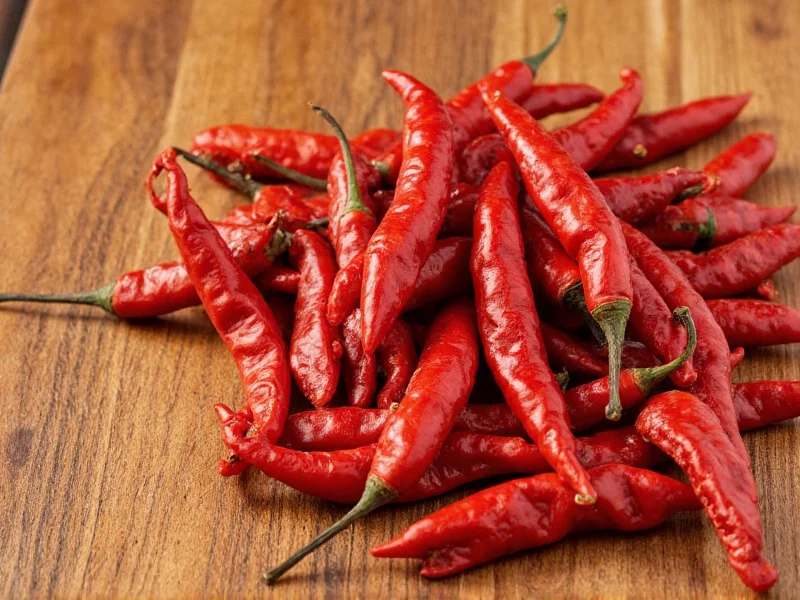Running out of dried chilies doesn't have to ruin your recipe. Understanding proper dried chili substitutes ensures your dishes maintain authentic flavor profiles while accommodating ingredient availability. This guide provides tested alternatives with precise ratios and flavor considerations for common cooking scenarios.
Understanding Dried Chili Characteristics
Dried chilies offer concentrated flavor and heat that fresh peppers can't replicate exactly. The drying process intensifies certain compounds while mellowing others, creating unique flavor profiles essential to many global cuisines. When seeking a dried chili pepper alternative, consider both heat level (measured in Scoville Heat Units) and flavor notes like smokiness, fruitiness, or earthiness.
Comprehensive Dried Chili Substitute Guide
Not all substitutes work equally well for every recipe. The right choice depends on whether your dish requires heat, flavor, color, or a combination. Below is a detailed reference for common substitutions:
| Original Dried Chili | Best Substitute | Substitution Ratio | Flavor Match | Heat Level Comparison |
|---|---|---|---|---|
| Ancho (dried poblano) | Guajillo pepper or sweet paprika + touch of cumin | 1:1 | ★★★★☆ | Milder (1,000-2,000 SHU vs 1,500-2,500 SHU) |
| Chipotle (smoked jalapeño) | Smoked paprika + cayenne | 1 tsp smoked paprika + ¼ tsp cayenne per chipotle | ★★★★★ | Slightly milder (2,500-8,000 SHU vs 5,000-10,000 SHU) |
| Guajillo | Ancho powder or New Mexico chilies | 1:1 | ★★★☆☆ | Milder (2,500-5,000 SHU vs 5,000-10,000 SHU) |
| Arbol | Cayenne pepper or Thai bird chili | ½ tsp cayenne per arbol | ★★★☆☆ | Slightly hotter (15,000-30,000 SHU vs 10,000-15,000 SHU) |
| pasilla | Prune + ancho powder or dried mulato | 1 pasilla = ½ tsp ancho powder + 1 chopped prune | ★★★☆☆ | Milder (1,000-2,500 SHU vs 1,000-2,500 SHU) |
Practical Substitution Strategies
When implementing how to replace dried chilies in recipes, consider these professional techniques:
Fresh Chilies as Dried Chili Pepper Alternatives
Fresh chilies work well as substitutes but require adjustment. Use a 3:1 ratio (three parts fresh to one part dried) since drying concentrates flavor. For best results, roast fresh chilies before use to mimic the depth of dried varieties. This approach works particularly well for recipes requiring whole chilies rather than ground powder.
Chili Powders and Flakes
Commercial chili powders vary significantly in composition. For authentic dried chili substitute results, make your own by grinding dried alternatives. Toast whole chilies in a dry skillet for 30-60 seconds before grinding to enhance flavor complexity. This homemade approach ensures no fillers or anti-caking agents affect your dish's flavor profile.
Sauce-Based Alternatives
When seeking a quick dried chili replacement, certain sauces can work in liquid-based recipes. Chipotle in adobo makes an excellent chipotle substitute (use 1 tbsp per dried pepper), while hot sauces like Tabasco can replace cayenne-based chilies. Remember to reduce other liquids in your recipe when using sauce alternatives.
Advanced Substitution Considerations
Professional chefs know that successful dried chili substitutes require understanding your recipe's flavor architecture:
- Heat management: Always add substitute heat gradually, tasting as you go. Dried chilies' heat distributes differently than fresh or powdered alternatives.
- Timing matters: Add powdered substitutes early for flavor infusion; add fresh chili alternatives later to preserve brightness.
- Texture considerations: For recipes relying on rehydrated chilies' texture (like mole), blend soaked fresh alternatives with a bit of tomato paste.
- Acidity balance: Dried chilies often bring natural acidity. When substituting, consider adding a splash of vinegar or citrus to maintain balance.
Common Substitution Mistakes to Avoid
Even experienced cooks make these errors when using dried chili pepper alternatives:
- Ignoring flavor profiles: Using cayenne as a direct ancho substitute creates heat without the necessary fruitiness.
- Incorrect ratios: Assuming 1:1 substitution works for all fresh-to-dried conversions (it doesn't - fresh contains water).
- Not toasting substitutes: Properly toasting alternative chilies unlocks flavors closer to authentic dried varieties.
- Overcompensating: Adding too much substitute when the first addition doesn't immediately register heat.
Dietary-Specific Substitutions
For special dietary needs, consider these dried chili replacement options:
Low-heat alternatives: Bell pepper powder (roasted and ground) provides color and mild flavor without heat. Use 1:1 ratio for decorative or flavor purposes without spiciness.
Smoky alternatives without chilies: A combination of smoked salt (¼ tsp) and sweet paprika (1 tsp) mimics chipotle flavor for those avoiding nightshades.
For histamine-sensitive diets: Freshly ground black pepper with a touch of cinnamon offers complexity without dried chili compounds that may trigger sensitivities.











 浙公网安备
33010002000092号
浙公网安备
33010002000092号 浙B2-20120091-4
浙B2-20120091-4